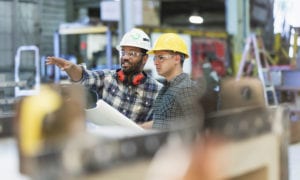Invest in manufacturing and construction again
Manufacturing and construction companies are still being hampered by COVID-19. Some companies are still under state and local restrictions, limiting workers, while others have issues keeping the workforce healthy enough to meet demands.

But the pandemic alone wasn’t the issue – trade policies, lack of investment in manufacturing and construction, supply chain problems (due to the coronavirus and climate change), lack of skilled workers available, and more have caused significant issues over the past few years.
According to Deloitte, it may take longer to reach pre-pandemic levels. The firm indicates, “Based on the Oxford Economic Model (OEM) anticipate a decline in annual manufacturing GDP growth levels for 2020-2021, with a forecast of -6.3% for 2020 and 3.5% for 2021.”
For construction, the outlook is mixed, depending on whether your business handles commercial or residential. Overall, the advice from Electrical Contractor is “sit tight into late 2021.” Yet, MarketWatch indicates the U.S. is also facing a housing shortage pushing the residential sector to rebound faster.
An unknown to manufacturing and construction — President Biden has released his proposals: a plan to Buy American and for infrastructure. Both these proposals rely on manufacturing and construction to revitalize the economy, including repairing aging highways, bridges, etc. Using American-made products.
Why invest in manufacturing and construction
It’s probably no surprise to you that it makes sense to invest in making and building – construction and manufacturing. According to the Washington Post, Walmart is investing $350 billion in U.S. manufacturing over the next 10 years. They’re not alone.
Overcome supply chain issues, keep consumer prices reasonable
It would be an understatement to indicate there have been severe supply chain issues over the past year. Goods from other countries are not being made at the same clip and those goods are often promised to their own country first. But that alone isn’t the issue. There are problems with shipping and transportation as well.
All these problems add up to goods being made slower, delivered slower, and made more expensively. The New York Times indicates that most goods will be more expensive as the source of those goods are more expensive to buy. Even at Lane Supply Company, we’re starting to see more price increases as businesses work to overcome these supply chain issues.
Boost the economy
Many believe that when the middle class thrives, the economy does well. With more tradespeople hired by manufacturing and construction companies, they’ll be more people earning middle-class wages. The theory is that they’ll spend more money on things that are made or built by those same companies. By ensuring the U.S. is the one that creates those things, the better the engine to our economy as it goes to companies to make and build more.
Why is this important? According to the Pew Research Center, people aren’t making that much more money in 2020 than they were in 1970. In fact, the middle class is making less than $30,000 more a year while the poorest Americans are making less than $10,000 more. No doubt you don’t need to be told prices for goods and services, though, are continuing to rise. That’s a squeeze to most Americans. Further, the Pew Research Center goes on to indicate that “the wealth of American families is currently no higher than its level two decades ago [from the Great Recession].”
Ouch.
Revitalizing the economy will help Americans recover from the Great Recession as well as boost an economy lagging from the pandemic.
How to help manufacturing and construction industries long term
Short-term solutions are important (such as buying American-made products and focusing on infrastructure), but we need more long-term help.
America needs to give manufacturing and construction the importance it deserves.
1. Back the trades to get more tradespeople

President Biden’s plan to boost the economy includes free community college, which for many colleges includes some trade classes such as welding. But not all community colleges focus on the trades.
Many high schools used to have “shop,” teaching people lifelong skills as well as a trade. Woodworking, automotive skills, electronic repairs, etc. were the curriculum at every school. Those graduates could then go on to a trade school to hone their skills or apprentice under a journeyman – an expert. No matter the reasons, this movement has caused a significant lack of skilled tradesmen in needed jobs. We need more high school programs again.
Here are just a few examples of shortages:
- By 2024, the welding industry will face a shortage of 400,000 welders.
- 60% of manufacturing job vacancies are because applicants don’t have the necessary skills.
- Six out of 10 construction companies have difficulty finding skilled applicants.
This lack of skilled tradespeople has affected manufacturing. Even in a pandemic, some companies can’t hire enough skilled tradespeople. That prohibits manufacturing and construction from keeping up with demand.
By investing and supporting the trades, including in schools, manufacturing and construction can continue to hire skilled workers. They can also continue to output to support American buying habits.
2. Rely on U.S. products to fix supply chain issues
Instead of turn to foreign products to help with manufacturing, companies should buy more American-made products.
It’s a ripple effect.
By relying on suppliers who provide American-made products, they’ll help other manufacturing companies, such as Milwaukee Tool, Integra Adhesives, Dynabrade, and 3M. These manufacturing companies can in turn increase their profits, hiring more skilled workers to meet increasing demands. Suppliers will continue to work with more American companies, potentially hiring more people. And so on.
When the economy is improving, more people can afford more things – such as new cars, houses, and other manufactured and crafted goods. It’s a win-win.
Elevated supports construction and manufacturing
At Elevated Industrial Solutions, formerly known as Lane Supply Company, we provide a host of great American-made products. Many of us in the office are makers and builders, too. From our offices in Colorado, Wisconsin, and Ohio, we’re helping manufacturing and construction companies to keep projects moving while saving time and money.
Let us help your supply chain to boost your business and the economy.

7 deadly sins of compressed air

Get your compressors ready after the holidays
